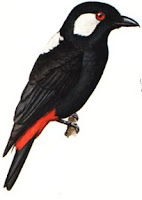 Peltops (Gr. pelte, a small shield; ops the face, Jobling 1991) are two very similar species
Peltops (Gr. pelte, a small shield; ops the face, Jobling 1991) are two very similar species endemic to the island of New Guinea. They are aberrant fly-catching species of uncertain affinity, previously included with the flycatchers, Muscipidae (Rand & Gillard 1967) but currently placed with the Australian Butcherbirds, Cracticidae (Beehler et al 1986). Currently known as Lowland and Mountain Peltops, in common with many other New Guinea birds they have gone under a variety of names e.g. Shieldbill (Rand & Gillard 1967), Crassbill (Mackay 1968). Peltops are boldly patterned black, white and red.
endemic to the island of New Guinea. They are aberrant fly-catching species of uncertain affinity, previously included with the flycatchers, Muscipidae (Rand & Gillard 1967) but currently placed with the Australian Butcherbirds, Cracticidae (Beehler et al 1986). Currently known as Lowland and Mountain Peltops, in common with many other New Guinea birds they have gone under a variety of names e.g. Shieldbill (Rand & Gillard 1967), Crassbill (Mackay 1968). Peltops are boldly patterned black, white and red.
Peltops  are predominatly glossy black with white patches behind the eye and onto the side of the neck and in the centre of the upper back. The rump, upper and under tail coverts are red. Both species are so similar that it was not until 1921 that montanus was even recognised as a subspecies (Diamond, 1972). Lowland Peltops occurs, as its name suggests, in lowland rainforest from sea-level to 550 m. Mountain Peltops inhabits hill and montane forest from 550m - 3000m (Beehler et al 1986). The latter is the bigger species, with larger white patches but the two species are best distinguished by voice. Lowland Peltops has a unique clicking song giving rise to an earlier name, Clicking Shieldbill. Mountain Peltops has a tinkling song and was previously known as Singing Shieldbill. Both species flycatch over open areas in the forest with long aerial sallies.
are predominatly glossy black with white patches behind the eye and onto the side of the neck and in the centre of the upper back. The rump, upper and under tail coverts are red. Both species are so similar that it was not until 1921 that montanus was even recognised as a subspecies (Diamond, 1972). Lowland Peltops occurs, as its name suggests, in lowland rainforest from sea-level to 550 m. Mountain Peltops inhabits hill and montane forest from 550m - 3000m (Beehler et al 1986). The latter is the bigger species, with larger white patches but the two species are best distinguished by voice. Lowland Peltops has a unique clicking song giving rise to an earlier name, Clicking Shieldbill. Mountain Peltops has a tinkling song and was previously known as Singing Shieldbill. Both species flycatch over open areas in the forest with long aerial sallies.
 are predominatly glossy black with white patches behind the eye and onto the side of the neck and in the centre of the upper back. The rump, upper and under tail coverts are red. Both species are so similar that it was not until 1921 that montanus was even recognised as a subspecies (Diamond, 1972). Lowland Peltops occurs, as its name suggests, in lowland rainforest from sea-level to 550 m. Mountain Peltops inhabits hill and montane forest from 550m - 3000m (Beehler et al 1986). The latter is the bigger species, with larger white patches but the two species are best distinguished by voice. Lowland Peltops has a unique clicking song giving rise to an earlier name, Clicking Shieldbill. Mountain Peltops has a tinkling song and was previously known as Singing Shieldbill. Both species flycatch over open areas in the forest with long aerial sallies.
are predominatly glossy black with white patches behind the eye and onto the side of the neck and in the centre of the upper back. The rump, upper and under tail coverts are red. Both species are so similar that it was not until 1921 that montanus was even recognised as a subspecies (Diamond, 1972). Lowland Peltops occurs, as its name suggests, in lowland rainforest from sea-level to 550 m. Mountain Peltops inhabits hill and montane forest from 550m - 3000m (Beehler et al 1986). The latter is the bigger species, with larger white patches but the two species are best distinguished by voice. Lowland Peltops has a unique clicking song giving rise to an earlier name, Clicking Shieldbill. Mountain Peltops has a tinkling song and was previously known as Singing Shieldbill. Both species flycatch over open areas in the forest with long aerial sallies.
When I began contracting in the mid-1990s I chose Peltops for my company name and logo to maintain my links with Papua New Guinea where my family and I lived for 6 years between 1985 and 1991. Peltops are boldly patterned birds but with only a few colours and so would be easy to reproduce on business cards and paper with a name that is relatively short and easy to remember.
References:
Beehler, B.M., T.K. Pratt & D. Zimmerman. 1986.
Birds of New Guinea. Princeton.
Birds of New Guinea. Princeton.
Diamond, J.M. 1972. Avifauna of the Eastern Highlands of New Guinea. Nutall Bird Club.
Jobling, J. 1991. A Dictionary of Scientific Bird Names. Oxford.
Mackay, R.D. 1968. Birds of Port Moresby and District. Nelson.
Rand, A.L. & E.T. Gillard. Handbook of New Guinea Birds. Weidenfeld & Nicolson.
Jobling, J. 1991. A Dictionary of Scientific Bird Names. Oxford.
Mackay, R.D. 1968. Birds of Port Moresby and District. Nelson.
Rand, A.L. & E.T. Gillard. Handbook of New Guinea Birds. Weidenfeld & Nicolson.